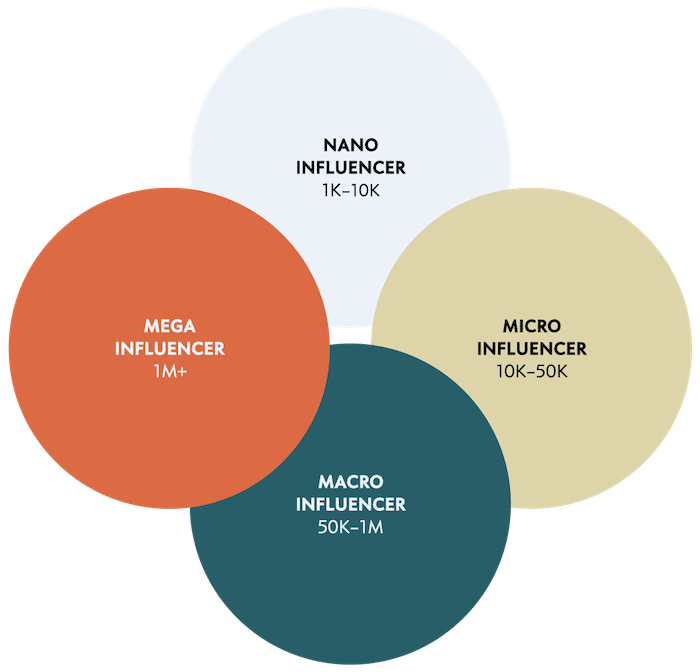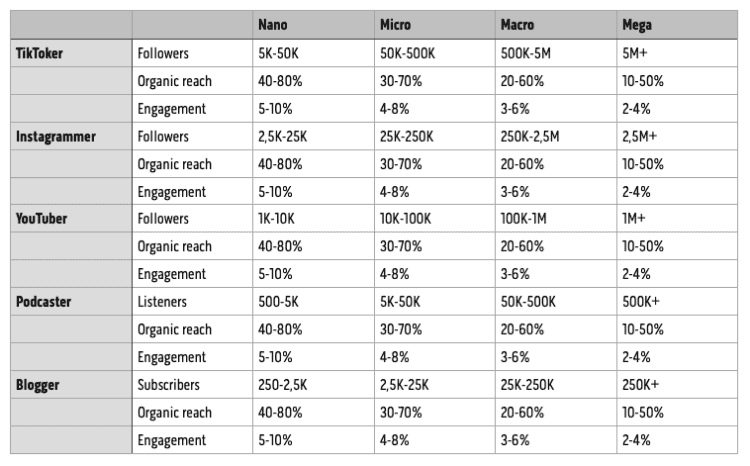What are influencers in public relations?
Quantifying is often challenging, especially when making sense of human behaviour. But most of us are faced with categorising influencers in social media anyway.
While you can find different types of online influencers on various platforms, I’ve chosen to look more closely at the media commonly targeted by businesses.
Here we go:
The Influencers in Public Relations
In public relations, influencers are individuals who have managed to grow a substantial audience, which has the potential to affect a specific organisation either positively or negatively.
Influencers = independent content creators with influential platforms and followings of potential importance to a brand. 1Silfwer, J. (2020, January 15). The Influencers in Public Relations. Doctor Spin | The PR Blog. https://doctorspin.net/influencers-in-public-relations/
Establishing and maintaining good relationships with strategically chosen influencers for the organisation is often critically important.
“Influencers in public relations are emerging stakeholders who generate a state of opinion in the digital community that surpasses traditional public opinion.”
Source: The Role of Prosumers in the Interactive and Digital Processes of Public Relations 2Polo, M. (2020). The Role of Prosumers in the Interactive and Digital Processes of Public Relations. 161 – 174. https://doi.org/10.4018/978 – 1‑7998 – 3119‑8.ch012
How To Categorise Influencers
There aren’t standardised terminologies for influencer marketing and influencer relations, and no general following sizes or engagement ratios exist. However, it’s possible to make approximate distinctions.

I recommend using the following tiers and naming conventions for categorising different types of influencers:
Learn more: The Influencers in Public Relations
Influencer Size Variations per Platform
To account for how different types of creator-based platforms work, I use this matrix to categorise social media influencers:

A few considerations for this matrix:
On varying creator-platform influence:
“Our research showed how trust is earned over time, with consumers tending to trust influencers on legacy platforms such as YouTube more (28%) than those on newer platforms such as Instagram (22%) and TikTok (15%).
However, influencers on both YouTube and TikTok fared well when compared to more traditional brand endorsements. 37% of 16 – 44-year olds trust a YouTube influencer more than a high-profile figure or celebrity. Meanwhile on TikTok, almost a quarter (23%) of the same age group agreed they trust a TikTok influencer’s recommendation over a friend.
And the survey shows how trust is converting into sales for brands. Over a quarter (27%) of consumers have been influenced to purchase a product or service by creators on YouTube in the past six months, followed by 24% of consumers on Instagram and 15% on TikTok. This increases to almost a quarter (23%) of 16 – 44 year-olds on the platform, showing how different demographics interact differently with each platform.”
Source: Influenceonline.co.uk 3Keane-Dawson, M. (2020, June 9). How will influencer marketing progress in 2020? Influenceonline.co.uk. https://influenceonline.co.uk/2020/06/09/how-will-influencer-marketing-progress-in-2020/
Influencer Marketing vs Influencer Relations
There are three main types of influencer marketing (digital marketing) and one primary type of influencer relations (digital PR):
Influencer Relations (Part of Digital PR)
Influencer outreach (earned media) = the influencer receives invitations, demos, or exclusive material without strings attached.
Influencer Marketing (Part of Digital Marketing)
Influencer advertising (paid media) = the influencer will publish the brand’s pre-made content in their channels.
Influencer sponsorship (paid media) = the influencer will read a script to convey an offering following the brand’s instructions.
Influencer collaboration (paid media) = the influencer showcases the brand’s offering by creating content similar to the influencer’s regular content.
Advertising, sponsorships, and collaborations are typically referred to as influencer marketing, and outreach is typically referred to as influencer relations.
Organisations looking to utilise the potential reach of relevant influencers will be wise to pay attention to these distinctions. 4Silfwer, J. (2020, January 15). The Influencers in Public Relations. Doctor Spin | The PR Blog. https://doctorspin.net/influencers-in-public-relations/
Learn more: Influencer Relations vs Influencer Marketing

THANKS FOR READING.
Need PR help? Hire me here.

What should you study next?
Spin Academy | Online PR Courses

Spin’s PR School: Free Introduction PR Course
Get started with this free Introduction PR Course and learn essential public relations skills and concepts for future success in the PR industry.
Introducing Public Relations
Public Relations History
Publics in Public Relations
Comparing Public Relations
Public Relations Resources
Learn more: All Free PR Courses
💡 Subscribe and get a free ebook on how to get better PR.

Annotations
| 1 | Silfwer, J. (2020, January 15). The Influencers in Public Relations. Doctor Spin | The PR Blog. https://doctorspin.net/influencers-in-public-relations/ |
|---|---|
| 2 | Polo, M. (2020). The Role of Prosumers in the Interactive and Digital Processes of Public Relations. 161 – 174. https://doi.org/10.4018/978 – 1‑7998 – 3119‑8.ch012 |
| 3 | Keane-Dawson, M. (2020, June 9). How will influencer marketing progress in 2020? Influenceonline.co.uk. https://influenceonline.co.uk/2020/06/09/how-will-influencer-marketing-progress-in-2020/ |
| 4 | Silfwer, J. (2020, January 15). The Influencers in Public Relations. Doctor Spin | The PR Blog. https://doctorspin.net/influencers-in-public-relations/ |


